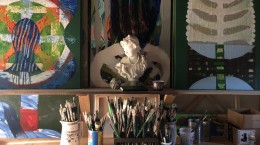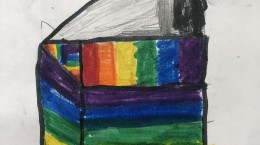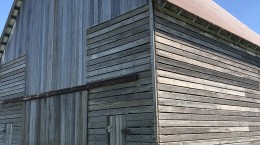Subscribe to Blog via Email
Recent Posts
Recent Comments
- Dante Ventresca (RSS) (57)
- Rebecca King (RSS) (32)
- Brad King (RSS) (1)
Authors
I Need This
- 11 years ago
- 0 Comments
- stories
- community, empathy, perseverance, place, story
Using a paint splattered rag, the paint now dry, I wipe off a porcelain tray. I left it outside yesterday. Honeysuckle blossoms, redbud twigs, and gooey stuff from unknown sources have accumulated on its surface from an early morning rain. “I need this tray,” I tell myself. As the weather turns warm I take my breakfast outside. With a scent of flowers encircling the studio I feel as if I’m being pushed out the door. Nature is giving a master class on beauty. There are open spaces in the yard where the first light of day is more than enough to put a few sentences together. This tray allows me to carry everything, tea, oatmeal, a fistful of almonds, and a notebook, in a single trip.
I see now, after I’ve cleaned it up a bit, the tray’s surface shines, looks brand new. I also see, in my mind’s eye, my mother polishing sliver, waxing old furniture, inspecting the water glasses as they come out of the dishwasher. While I was growing up my mother’s actions were always saying, “take care of the things you have” and “give meaning to familiar objects”.
My mother, Marie, born 1919, doesn’t discuss philosophy. She puts important stuff together. True story: In 1963, twelve of us piled into a station wagon and we drove from Brownsburg, Indiana to Berkeley, California. Once there my father spent his days studying at Lawrence Livermore while my mother put a home together from scratch. She started this process by taking a course on children’s literature and borrowing original artwork from the Berkeley library. She hung the art on the bare walls. She read the hot-off-the-press illustrated books to her kids. She wrapped us in beauty and stoked our imagination.
I was thinking about my mother’s decision to put borrowed art on those blank walls when Rebecca and I walked through the remains of Pass Christian, Mississippi. We drove over from Mobile, Alabama where we were working on a couple of projects. This was a few months after Hurricane Katrina destroyed almost all of it. Only 500 of the 8,000 houses remained. What had been a beach front vacationland was now a wasteland. We could make out the streets and the house foundations. There were the swimming pools filled with brackish water and everything else. These big buried bowls of cement held refrigerators, gutters, chunks of side walk. There were twisted iron gates, snapped telephone poles, parts torn from automobiles, dolls, tables, chairs, a torn and painted canvas.
Here were the facts. These were the scattered things that once belonged in homes people had made. After the storm, survivors created shrines from what remained. These personal little temples were all around us. They were pieced together using familiar stuff, ordinary objects, things that belonged in kitchens, bedrooms, and living rooms. Here were pieces from the game of Monopoly, a candlestick, a book. Here was a stack of floral patterned dishes that had been washed off and stacked. As Rebecca and I silently made our way through town we saw people still adding to these shrines, still putting the pieces together.
I didn’t need my imagination. All the small things that mattered a little, that when collected together had made homes, had made a town, now served the memory. The memory of the town and the lives lived there found expression in those impromptu shrines. Today it is easy enough for me to see my little tray and the bowl that holds my oatmeal being placed on one of this little temples. I can find a place for the artwork that my mothered borrowed from the library in 1963. And under a chunk of bare wall used as a paper weight there is even enough room for a note – a reclaimed post-it note with my to do list with today’s date scribbled at the top. “I need this note,” I tell myself.



